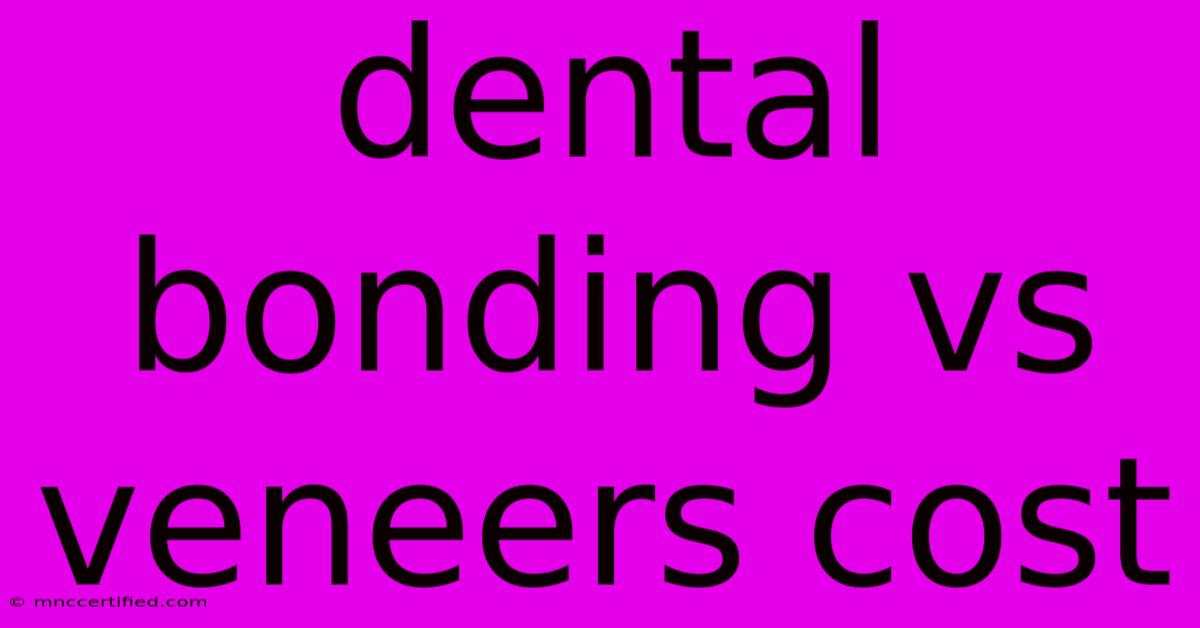Dental Bonding Vs Veneers Cost

Table of Contents
Dental Bonding vs. Veneers: A Cost Comparison and Guide
Choosing between dental bonding and veneers can be a significant decision, especially when considering the cost. Both procedures improve the appearance of your teeth, but they differ significantly in price, longevity, and the overall process. This comprehensive guide will delve into the cost comparison of dental bonding versus veneers, helping you make an informed decision based on your needs and budget.
Understanding the Procedures
Before diving into the cost differences, let's briefly understand what each procedure entails:
Dental Bonding
Dental bonding is a conservative and relatively inexpensive cosmetic procedure. A tooth-colored resin is applied to the tooth's surface, sculpted to the desired shape, and then hardened with a special light. It's often used to repair chipped or cracked teeth, close gaps, and improve the overall appearance of discolored teeth.
Key Advantages of Bonding:
- Less Invasive: Minimal tooth preparation is required.
- Affordable: Significantly cheaper than veneers.
- Quick Procedure: Often completed in a single visit.
Key Disadvantages of Bonding:
- Shorter Lifespan: Bonding typically lasts 3-10 years, depending on care and location.
- Susceptible to Staining: Can be stained by coffee, tea, and other pigmented substances.
- Not as Strong: Less durable than veneers and more prone to chipping.
Dental Veneers
Dental veneers are thin, custom-made shells of porcelain or composite resin that are bonded to the front surface of teeth. They are primarily used to improve the appearance of teeth that are stained, chipped, misshapen, or gapped. Veneers offer a more permanent and dramatic improvement in aesthetics.
Key Advantages of Veneers:
- Natural Look: Highly realistic and natural-looking.
- Stain Resistant: Less prone to staining than bonding.
- Longer Lifespan: Can last 10-15 years or even longer with proper care.
- Strong and Durable: More resistant to chipping and wear.
Key Disadvantages of Veneers:
- More Expensive: Significantly more costly than bonding.
- More Invasive: Requires more tooth preparation, usually involving some enamel removal.
- Irreversible: Once applied, veneers cannot be easily removed.
Cost Comparison: Bonding vs. Veneers
The cost of both procedures varies considerably based on several factors:
- Location: Costs differ significantly between geographic areas and dental practices.
- Number of Teeth Treated: The more teeth treated, the higher the overall cost.
- Material: For veneers, porcelain is generally more expensive than composite resin.
- Dentist's Experience: Experienced cosmetic dentists often charge more.
General Cost Estimates (USD):
- Dental Bonding: $300 - $1000 per tooth.
- Porcelain Veneers: $800 - $2000 per tooth.
- Composite Veneers: $500 - $1500 per tooth.
Note: These are average estimates. It's crucial to consult with your dentist for a personalized cost breakdown based on your specific needs and situation.
Factors Influencing Your Decision
Beyond the cost, other factors should influence your choice:
- Severity of Imperfections: For minor imperfections, bonding might suffice. For significant issues, veneers are often a better choice.
- Lifestyle: If you consume staining beverages regularly, veneers might be a more suitable option.
- Long-Term Investment: Veneers are a more significant investment but offer a longer lifespan.
Finding the Right Dentist
Choosing the right cosmetic dentist is paramount. Look for a dentist with extensive experience in both bonding and veneer procedures. Schedule consultations with multiple dentists to compare costs, treatment plans, and their approach to patient care. Don't hesitate to ask detailed questions about the procedures, materials, and the expected results. Request before-and-after photos to assess the dentist's skill and aesthetic sense.
Conclusion
The decision between dental bonding and veneers depends on your individual needs, budget, and expectations. While bonding is a more affordable option for minor cosmetic issues, veneers offer a longer-lasting and more dramatic improvement. By carefully weighing the costs, benefits, and risks of each procedure, and consulting with a qualified dentist, you can make an informed decision that leads to a healthy and beautiful smile. Remember to always prioritize your oral health and choose a treatment plan that aligns with your long-term goals.

Thank you for visiting our website wich cover about Dental Bonding Vs Veneers Cost. We hope the information provided has been useful to you. Feel free to contact us if you have any questions or need further assistance. See you next time and dont miss to bookmark.
Featured Posts
-
Eli Apple Back On Active Roster
Nov 26, 2024
-
U Conn Womens Basketball Defeats Oregon State
Nov 26, 2024
-
Watch Ravens Chargers Monday Night Football
Nov 26, 2024
-
La Chargers All Star Flag Football Photos
Nov 26, 2024
-
Topps Stadium Club Barry Bonds
Nov 26, 2024